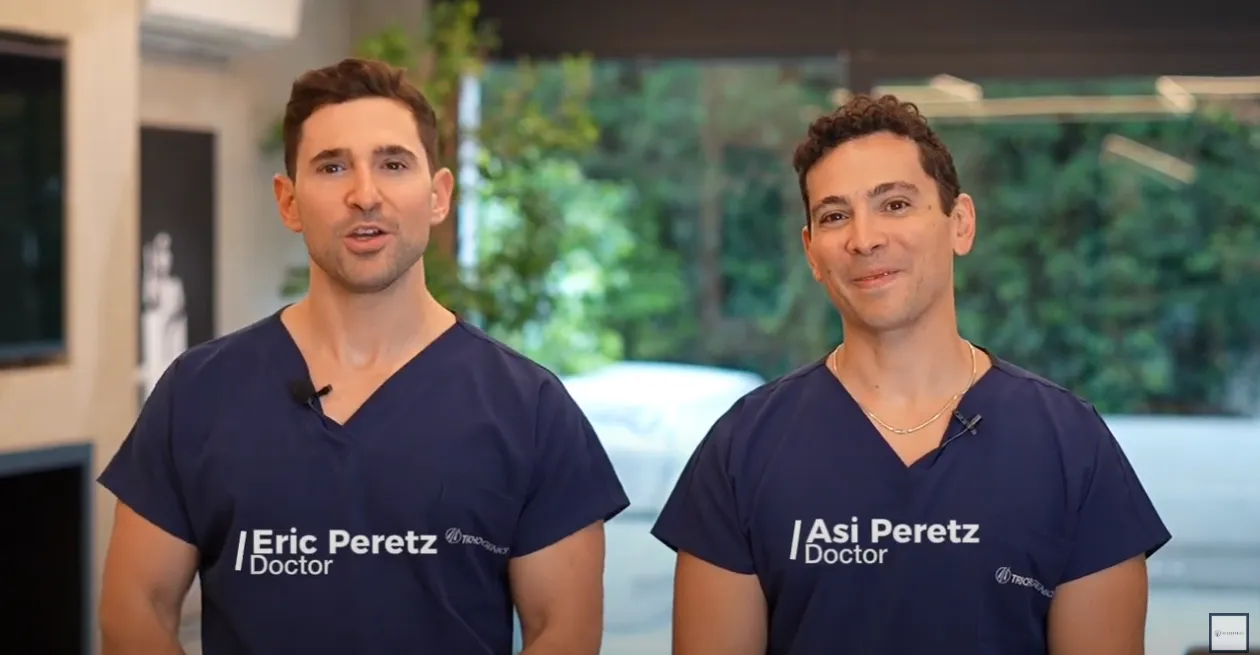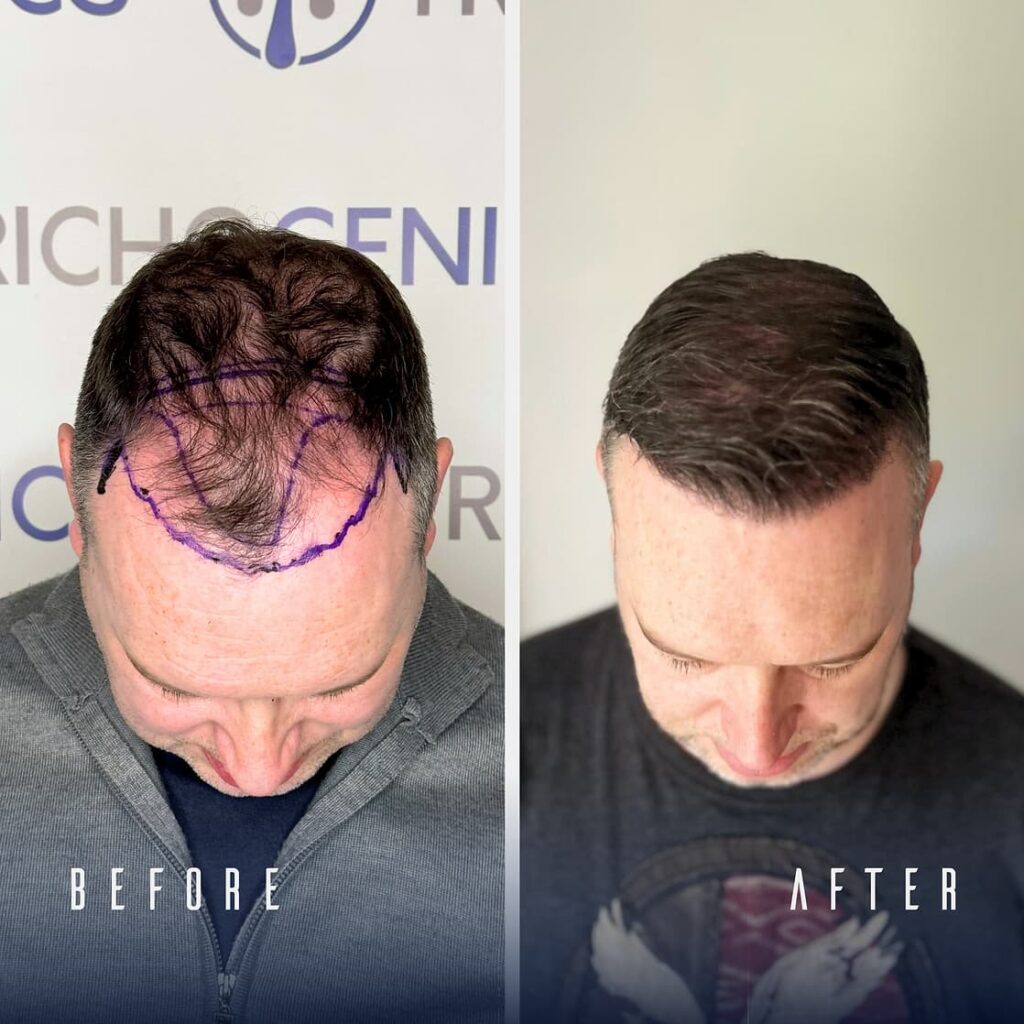At Trichogenics, Dr. Asi Peretz and Dr. Eric Peretz provide advanced hair restoration in Greece and Israel. Many people ask if a hair transplant from another person is possible. This guide explains the science, the risks, and why choosing Trichogenics is the safest way to restore natural hair growth.
Key Takeaways
- A hair transplant from another person cannot be done. The immune system rejects foreign hair follicles. This makes the procedure unsafe, even with strong medications.
- The safest way to cover bald spots is with hair restoration surgery. This method uses your own hair. Individual hair units are taken and implanted for permanent growth.
- Techniques like FUE and FUT help surgeons take hair follicles from the scalp or body. This helps patients get natural–looking results without the risk of rejection.
- Choosing Trichogenics in Greece and Israel provides doctor-performed procedures, strict medical standards, and personalized care that protect your health and deliver lasting outcomes.
Can You Transplant Hair From Someone Else?
@trichogenics Can you use someone else’s hair for your HAI TRANSPLANT!? #hairtransplant #hairtransplantsurgery #hairtransplantturkey #hairtransplantgreece #hairtransformation #hairlosssolutions #haircare #trichogenics #finasteride #dutasteride #minoxidil
♬ original sound - Trichogenics
The answer is no. A hair transplant with donor hair from another person does not work for normal treatment. Your immune system sees someone else’s hair follicles as foreign tissue, like in organ transplants, and attacks them. Even with a good match, the body rejects individual hair follicles because they carry different genetic markers.
Doctors have tried cross-person transplants in research, but success is very rare. Without lifelong use of strong drugs to suppress the immune system, the transplanted individual hairs will not survive in the new recipient area.
Why Transplants From Another Person Fail
Hair follicles contain proteins that the immune system checks. When follicles from else’s hair are implanted, immune cells attack, causing swelling and graft failure.
To stop this, a patient would need powerful drugs similar to those used after organ transplants.
These drugs raise the risk of infection, cancer, and other serious problems, making them unsafe for a cosmetic procedure like a hair transplant surgery.
Rare Exceptions and Scientific Evidence
A few special cases show limited success:
- Identical twins share the same genetic code, which prevents immune rejection.
- Some organ transplant patients who already take immune-suppressing drugs have had small experimental procedures.
These rare cases prove that only a perfect genetic match can avoid graft rejection.
Donor Hair Options and Limitations
Because using another person’s hair is not safe, the best choice is your own hair transplant donor area.
Surgeons pick healthy follicles from the back or sides of the scalp, called the donor site, where hair resists thinning. These follicles are then implanted into thin or bald spots to trigger natural hair growth.
Using Your Own Hair Transplant Donor Area
Your own scalp gives the most reliable donor supply. During a hair transplant procedure, surgeons remove hair grafts with individual hair follicles from stable areas.
Because these follicles come from your own body, the immune system accepts them and the transplanted hair keeps growing.
Can You Transplant Hair From Other Parts of the Body?
Yes, sometimes. Body hair transplantation lets doctors use hair from the chest, beard, or legs if scalp supply is low.
While scalp hair is still the best match for texture and growth, body hair can expand the available parts of the body for harvesting.
Procedure and Safety Considerations
@trichogenics This is what you need to look out for when it comes to world class hair transplants. Dr Asi Peretz explains #hairtransplant #trichogenics #hairtransplantturkey #hairtransplantsurgery #hairtransplantation #hairloss #naturalhair #hairfall #hairlosssolutions #FUE #fy
♬ original sound - Trichogenics
A modern hair transplant uses careful surgical methods to remove and place follicles while keeping them healthy. At Trichogenics, all procedures are doctor-performed to meet strict medical standards.
FUE and FUT Donor Techniques
Two main methods are used:
- Follicular Unit Extraction (FUE): Single follicles are removed one by one. This method, also called FUE hair transplantation or follicular unit extraction FUE, leaves tiny scars and allows fast healing.
- Follicular Unit Transplantation (FUT): A small strip of scalp is removed from the donor site, and follicular unit transplant (FUT) grafts are prepared. FUT can provide more grafts in one session.
Both methods are safe when done by skilled doctors and can treat male pattern baldness.
Risks of Immunosuppressive Treatment
Trying a hair transplant with donor hair from another person would require lifelong immune-suppressing drugs. These drugs can cause infections, liver problems, and higher cancer risk. For a cosmetic procedure, these dangers are far too high.
Future Solutions and Research
Researchers are studying hair cloning and follicle multiplication. These methods aim to create new follicles from a patient’s own cells, removing donor limits. Early results look promising, but these treatments are still in testing and not yet available.
Preparing for a Hair Transplant
Before surgery, meet with a qualified doctor to discuss goals, donor supply, and expected results. At Trichogenics, Dr. Asi Peretz reviews every case to design a safe and personal plan.
Questions to Ask Your Surgeon
Ask about:
- The best donor area for your hair type.
- How many hair grafts you need.
- The recovery timeline and follow-up care.
- Safety steps and long-term results.
Recovery and Results Timeline
Most patients return to normal activity in a few days. New hair growth starts after three to four months, with full results in 9–12 months. Because the transplanted follicles resist balding, the results are permanent.
Expert Surgeon Insights
At Trichogenics in Greece and Israel, every hair transplant surgery is performed by licensed doctors. Dr. Asi Peretz and Dr. Eric Peretz have years of experience in safe and advanced techniques.
Their doctor-led care ensures careful planning and natural results.
Why Choose Greece or Israel Instead of Turkey
Some patients look for cheaper options in Turkey. We strongly recommend against this. Turkey has weak medical rules, and many clinics lack proper oversight. Reports of untrained staff and unsafe practices are common.
Reasons to avoid Turkey for hair restoration:
- Weak medical regulations and little government control.
- Risk of unqualified or unlicensed operators.
- Higher rates of infection and poor outcomes.
- Limited legal protection for patients.
Choosing Trichogenics in Greece or Israel gives you strong medical standards, modern facilities, and expert doctors.
Practical Tips for Better Results
Follow these steps for the best outcome:
- Pick a clinic where doctors perform the surgery, not technicians.
- Check the surgeon’s training in follicular unit transplantation FUT and FUE hair transplantation.
- Ask about both scalp and body hair transplantation if donor supply is low.
- Follow all post-surgery care to protect new grafts and support healthy hair growth.
- Attend follow-up visits to track healing and results.
Why Choose Trichogenics?

All procedures are performed only by doctors
The uniqueness of Trichogenics lies in its strict medical process—only certified doctors perform every transplant.
No technicians or unqualified assistants are involved. Choosing a clinic with proven experience in hair transplants can make all the difference.
Meet Dr. Asi and Dr. Eric Peretz
The two doctors leading Trichogenics—Dr. Asi Peretz and Dr. Eric Peretz—are recognized leaders in the field. Their extensive experience, attention to detail, and focus on natural results make Trichogenics the best choice.
Celebrity Hair Transplants
Who has undergone the procedure at Trichogenics? The answer is clear: a safe, professional clinic that delivers results that look great even under camera lights.
Contact Trichogenics today to schedule a personal consultation and get a clear, doctor-led plan for your hair restoration.



